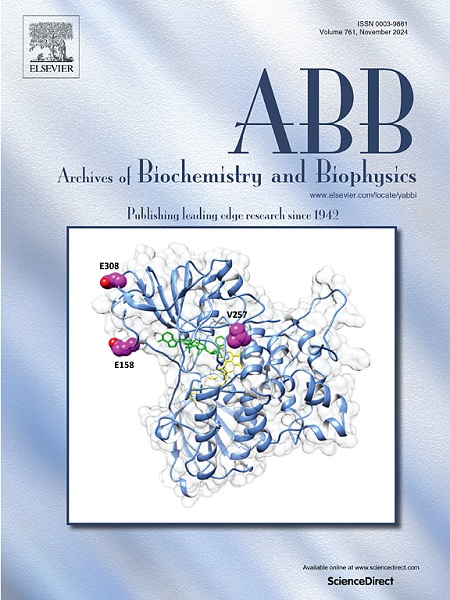膜联蛋白A2 Ca2+结合域的E53, E96, D162, E247和D322是通过ERK1/2和JNK信号通路调节细胞内[Ca2+]和晶体对肾细胞的粘附所必需的
IF 3.8
3区 生物学
Q2 BIOCHEMISTRY & MOLECULAR BIOLOGY
引用次数: 0
摘要
膜联蛋白A2 (ANXA2)在细胞质内和肾小管上皮细胞(RTECs)表面表达,是一种草酸钙一水合物(COM)晶体结合蛋白。然而,其参与肾结石疾病(KSD)的分子机制仍未得到充分研究。在此,我们进行了各种分子分析,以揭示ANXA2及其核心残基(E53, E96, D162, E247和D322)在其Ca2+结合域中在结石形成机制中的作用,特别是在晶体细胞粘附步骤和下游信号级联中。COM晶体暴露后,rtec根尖膜中的ANXA2表达上调,而细胞质中则没有。用特异性单克隆抗体中和ANXA2的表面表达,并用小干扰RNA (siRNA)沉默其表达,可显著降低COM晶体细胞粘附。siRNA也抑制com诱导的phospho-ERK1/2和phospho-JNK的上调,但不抑制phospho-p38的上调。过表达其Ca2+结合域的ANXA2野生型(WT),而不表达其Ca2+结合域的E53A、E96A、D162A、E247A和D322A突变体,显著增加细胞内[Ca2+]、com细胞粘附和磷酸化erk1 /2水平。因此,膜联蛋白A2 Ca2+结合域的E53、E96、D162、E247和D322是通过ERK1/2和JNK信号通路调节胞内[Ca2+]和COM晶体细胞粘附所必需的。本文章由计算机程序翻译,如有差异,请以英文原文为准。
![E53, E96, D162, E247 and D322 in Ca2+-binding domains of annexin A2 are essential for regulating intracellular [Ca2+] and crystal adhesion to renal cells via ERK1/2 and JNK signaling pathways](https://img.booksci.cn/booksciimg/2025-4/101302660891774748956.jpg)
E53, E96, D162, E247 and D322 in Ca2+-binding domains of annexin A2 are essential for regulating intracellular [Ca2+] and crystal adhesion to renal cells via ERK1/2 and JNK signaling pathways
Annexin A2 (ANXA2) is expressed inside the cytoplasm and on the surface of renal tubular epithelial cells (RTECs) and is documented as a calcium oxalate monohydrate (COM) crystal-binding protein. Nevertheless, its molecular mechanism involved in kidney stone disease (KSD) remains underinvestigated. Herein, we performed various molecular assays to unravel the roles of ANXA2 and core residues (E53, E96, D162, E247 and D322) in its Ca2+-binding domains in the stone formation mechanism, particularly at crystal-cell adhesion step and downstream signaling cascade. ANXA2 was up-regulated in apical membranes, not cytosol, of RTECs after COM crystal exposure. Neutralizing the surface expression of ANXA2 by a specific monoclonal antibody and silencing its expression by small interfering RNA (siRNA) significantly decreased COM crystal-cell adhesion. siRNA also suppressed the COM-induced up-regulation of phospho-ERK1/2 and phospho-JNK, but not that of phospho-p38. Overexpression of ANXA2 wild-type (WT), but not that of E53A, E96A, D162A, E247A and D322A mutants of its Ca2+-binding domains, significantly increased intracellular [Ca2+], COM-cell adhesion, and phospho-ERK1/2 level. Therefore, E53, E96, D162, E247 and D322 in the Ca2+-binding domains of annexin A2 are essential for regulating intracellular [Ca2+] and COM crystal-cell adhesion via ERK1/2 and JNK signaling pathways.
求助全文
通过发布文献求助,成功后即可免费获取论文全文。
去求助
来源期刊

Archives of biochemistry and biophysics
生物-生化与分子生物学
CiteScore
7.40
自引率
0.00%
发文量
245
审稿时长
26 days
期刊介绍:
Archives of Biochemistry and Biophysics publishes quality original articles and reviews in the developing areas of biochemistry and biophysics.
Research Areas Include:
• Enzyme and protein structure, function, regulation. Folding, turnover, and post-translational processing
• Biological oxidations, free radical reactions, redox signaling, oxygenases, P450 reactions
• Signal transduction, receptors, membrane transport, intracellular signals. Cellular and integrated metabolism.
 求助内容:
求助内容: 应助结果提醒方式:
应助结果提醒方式:


